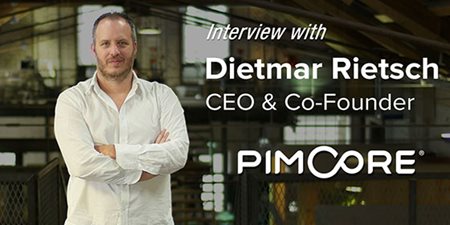Pimcore Gives Back Control with Open-Source
By Natalie Evans
December 19, 2018
CMS, Content Management System, data management, Digital Asset Management, Digital Experience, ecommerce, eCommerce Platform, gartner, open source, PIM, Pimcore
Founded in 2013, Austrian start-up Pimcore is an open-source platform for data and customer experience management that has been making waves in recent news. Led by German Auctus Capital, Pimcore has raised $3.5 million in Series A funding which will support the tech startup’s US expansion and continued development of content and commerce capabilities for product and service enterprises.
Integrating out-of-the-box product information management, content management, data asset management, and e-commerce functionalities, Pimcore enables control of all digital data and customer experience. While several companies are doing this, what makes Pimcore so unique is that they are the only open-source platform that is an out of the box solution available right now that directly competes with propriety products which include expensive licensing costs. I was given a chance to connect with CEO and Co-Founder Dietmar Rietsch, to talk about his company, the advantages that open-source offers that is conducive to the innovation we’re seeing in the space and the most significant trends and technologies that will disrupt the way we currently view the relationship between content and commerce.
Your press release mentioned “We’ve identified an incredible need for more flexible and connected data solutions for global enterprises, and strongly believe control over intellectual property and software belongs in the hands of our customers. That’s why we’ve developed our technology to be completely free of license cost,” could you expand a bit more on the needs that you see in the market, and what are your hopes that Pimcore will fill?
“Today, organizations have so much data from multiple domains on hand that they’re not really sure what to do with it. Often times, files get passed from person to person across the company, ending up in various file formats, in decentralized locations, with no identifiable source. This makes it really difficult for marketing and sales to actually leverage that data and develop any actionable insights from it to improve the customer experience. When it comes to commerce, these insights are crucial to drive strategy across all customer touchpoints and channels, as unique shopping experiences are what drive customer loyalty in today’s competitive market.
Pimcore is an open-source framework that global enterprises can leverage to fill these gaps. Pimcore offers a centralized platform where organizations can properly manage product information, data assets, customer experiences, and e-commerce functionalities, avoiding all of the potential issues that come along when data isn’t streamlined into a single location. Since customer demands are constantly changing in this day and age, Pimcore provides a flexible and agile solution that allows organizations to move quickly from concept to launch and iterate on their processes as these needs change. This is what’s required for organizations to stay competitive and retain market share today.”
Congratulations on being recognized in the 2018 Gartner Cool Vendor report, could you tell us what this means to you?
“Being named a Gartner Cool Vendor in 2018 was a huge win for us. To have our company highlighted by such a reputable organization as having a product that’s finding new ways to solve legacy problems and create unique data-driven commerce experiences for our customers really got to the core of what we want to be known for. We believe that open-source is poised to transform commerce as we know it. The agility, flexibility, and scalability of the software allows it to be leveraged across industries to create the personalized experiences that customers demand today, which is why we offer the product without license cost. It’s been amazing to watch our customers interact with the product and evolve their commerce processes, and being recognized for that by Gartner is a great accomplishment.”
You also mentioned, “All innovation in recent years in areas such as cloud computing, big data, and artificial intelligence have happened in open-source ecosystems. It has become the primary engine of innovation all around the world,” Could you expand on this and tell us why you think this is happening within open-source, or what advantages does open-source offer that is conducive to the innovation we’re seeing in that space?
“The reason that we’ve seen so many innovations arise in open-source ecosystems over the past few years is because of the flexibility and scalability that these softwares provide. In order for global enterprises to stay viable today, they need to move at the speed of their customers, which just can’t be accomplished in rigid legacy ecosystems. Open-source allows for continuous iterations as customer needs change, without the constraints of contracts and licensing fees, and provides organizations the ability to make tweaks to the software as it suits their needs. Open-source is a more appropriate solution for the speed at which the enterprise is moving, and we love being able to show the benefits of the tech for data, content, and commerce with our platform.”
What do you think will be the most significant trends and technologies to disrupt the way we currently view the relationship between content and commerce?
“Commerce today is all about responding to unique customer needs, at any time and across all touchpoints. The ability to provide relevant, accurate content to them at every interaction is crucial in order to keep consumers shopping with one company over another - the experience drives everything. Players in the digital commerce realm know they need to create these unique experiences and seek out ways to achieve agility while offering personalized content at every customer touchpoint.
To achieve this, I believe we’ll see open-source technology playing a much larger role in commerce as organizations need flexible, centralized platforms where they can properly manage relevant customer data to create effective content and offer these unique experiences. Since customer demands change so quickly, digital commerce players must have the processes in place that can quickly change with these needs, and open-source softwares provide a strong framework to do so. In addition, I think we’ll see cloud-based systems increasingly making their way into the commerce space as another flexible solution that allows for quick iterations as customer needs evolved. Since it’s all about speed to market today, these solutions will play a huge role in separating the serious commerce players from those who think that sticking with their antiquated methods will breed success.”
Ending Notes
In recent years there has been a lot of innovations taking place in the open-source ecosystem, cloud computing, big data and artificial intelligence (AI). This has led to the flood gate opening and enabling open-source to extend its capabilities to current and future customers in 2019 and beyond. Pimcore also mentioned that they are looking to launch Pimcore cloud, sometime during mid-2019.
No matter how you choose the platform that’s most suited to your need, there will always be a couple of things that will still make a difference to your business flexibility and seamless customer experience. Pimcore’s consolidated open-source platform for PIM/MDM, DAM, WCM, and eCommerce seems like it will be the one that will genuinely impact the industry.

Natalie Evans
Natalie Evans has over 16-years in the tech industry and currently works as the event coordinator and tech reporter for CMS-Connected, keeping up-to-date on what's happening in and around the Content Management industry.